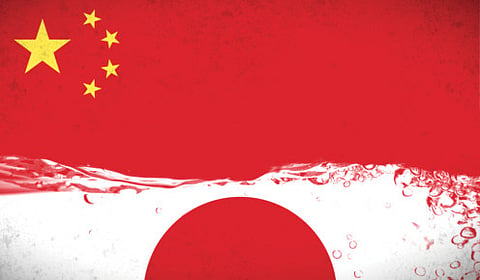China may have overplayed its hand on the islands
In the longer run, Beijing may seek to drive a wedge between Japan and the US

About a year ago, I was in the office of Albert del Rosario, the Foreign Minister of the Philippines. What, I asked, would Manila say if Shinzo Abe, then running for prime minister of Japan, carried out his pledge to amend the pacifist constitution and “rearm”? (In fact, Japan is already fully armed, but its constitution bars use of force except in self-defence.) I fully expected him to reply that this would be a regrettable move. Not only would it be enormously provocative to China but memories of the country’s invasion of the Philippines, in which rape and civilian slaughter were common, were surely just as raw in Manila as they were in Beijing and Seoul. Not a bit of it, he said. “We would welcome that very much. We are looking for balancing factors in the region and Japan could be a significant balancing factor.”
Those remarks, echoed by Indonesia’s foreign minister, came back to me last week as China and Japan squared off dangerously over disputed islands in the East China Sea. At the weekend, Beijing took many by surprise when it announced the creation of an “air defence identification zone”, covering the islands known as Senkaku by Japan and Diaoyu by China. There is nothing unusual about establishing such a zone. Many countries have them, including Japan and the US. Yet, the move is provocative because China’s zone overlaps Japan’s. From now on, Beijing says, aircraft entering the zone will have to identify themselves to Chinese authorities or face unspecified “emergency defence measures”.
Abe denounced the move, which he said had no legitimacy. Washington, too, has strongly objected. It sent two B52 bombers across the zone — without telling Beijing in advance — to underline its displeasure. Japan’s two main civilian airlines initially complied with the order but, under pressure from Tokyo, resumed flying across the zone last Wednesday, without informing Chinese authorities.
China’s aim appears to be to change the facts on the ground — or, in this case, in the air. Its new zone challenges Japan’s longstanding de facto control of the islands, which it incorporated into its territory — China says illegally — in 1895. In the short term, Beijing hopes to force Japan to admit that sovereignty over the islands is in dispute, something it refuses to acknowledge. In the longer run, China may seek to drive a wedge between Japan and the US. Although Washington takes no position on the islands’ sovereignty, it says they fall under the remit of the US-Japan security treaty. That implies it would come to Japan’s aid if the islands were attacked. Yet, China cannot be the only country to wonder whether Washington would really risk American lives to defend a few barren rocks.
On the face of it, this is a good fight for Beijing to pick. One might advise it to do exactly the same as a way of ratcheting up pressure on Japan and advertising its regional ambitions. After all, one might argue, there is little love lost for Japan in the region, especially under Abe, considered a revisionist who quibbles over many of Japan’s wartime atrocities. Washington is desperate for Seoul and Tokyo to get along. Instead, they are barely on speaking terms. Park Geun-hye, the President, has refused to meet Abe until he has developed a “more sincere” attitude towards Japanese history. She instead made a high-profile visit to Beijing.
Yet, other Asian countries, even ones that suffered at the hands of Japan’s Imperial Army, do not harbour the same bitterness. Many of the region’s nations, including the Philippines, Vietnam and India, have become increasingly wary of a rising China as it becomes more assertive about its territorial claims. They have encouraged the US to “pivot” back to the region. And many of them have edged closer diplomatically to Japan, an important — in some cases, the most important — investor in their economies.
In an unprecedented diplomatic charm offensive, Abe has visited all 10 members of the Association of Southeast Asian Nations in his first year in office. Japanese companies, backed by the government, have sharply stepped up their presence in Indonesia, the Philippines and Myanmar. The latter, until recently firmly in China’s orbit, has slipped out of its diplomatic grasp as it opens up to the West.
The hedging against China is not just commercial. Many countries in the region, including the Philippines and Vietnam, are stepping up military co-operation with the US. Japan has supplied ships to Manila to patrol waters disputed with China and is in discussion with Hanoi to do the same. Even South Korea has objected strongly to China’s new exclusion zone. China’s lack of soft power was on display in the days after Typhoon Haiyan ripped through the Philippines. The US sent the USS George Washington, Japan sent 1,000 self-defence troops and plenty of money. China’s initial contribution, a mere $100,000 (Dh367,800), was widely condemned as petty and mean-spirited.
One could argue that, as China’s economy grows, it is only natural that its regional footprint will also expand, not always to the liking of its neighbours. After all, as long ago as the Monroe Doctrine of 1823, the US declared Latin America off-limits to European powers. Yet, Beijing may be overplaying its hand. In Japan, China’s action may make it easier for Abe to scrap a self-imposed ban on collective self-defence or even eventually to ditch the pacifist constitution. Whether regional leaders like his nationalistic sentiments or not, many of them will be hoping he does not blink.
— Financial Times
Sign up for the Daily Briefing
Get the latest news and updates straight to your inbox


